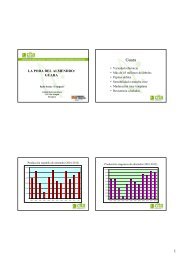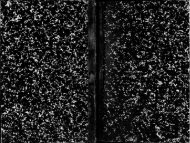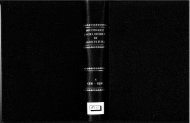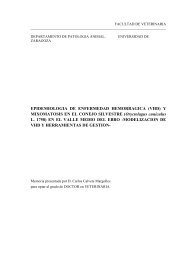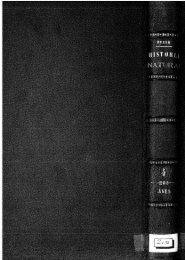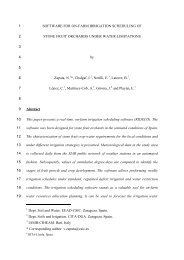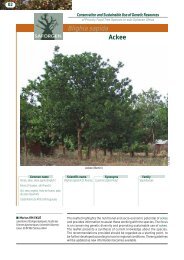1 A Recursive Dynamic Computable General Equilibrium Model For ...
1 A Recursive Dynamic Computable General Equilibrium Model For ...
1 A Recursive Dynamic Computable General Equilibrium Model For ...
You also want an ePaper? Increase the reach of your titles
YUMPU automatically turns print PDFs into web optimized ePapers that Google loves.
Given that set-aside is mainly composed of an obligatory component 20 (subject to the<br />
small farm exemption), we treat this as an exogenous policy variable. Thus, we characterise<br />
the set-aside of cereals, oilseeds and protein (COP) crops sectors employing an exogenous<br />
productivity variable (a1lnd), 21 where exogenous negative (positive) shocks to the variable<br />
a1lndi capture reductions (increases) in set aside land compared with the 2005 benchmark.<br />
Introducing the concept of an effective unit of land (denoted by superscript ‘e’) and a<br />
productive quantity of land the relevant price and quantity equations (in linear terms) are<br />
denoted as:<br />
x1ln<br />
d<br />
p1ln<br />
d<br />
e<br />
i<br />
e<br />
i<br />
= x1ln<br />
d + a1land<br />
i<br />
= p1ln<br />
d − a1land<br />
i<br />
i<br />
i<br />
Thus, a positive exogenous reduction in ‘a1lnd’ by 10% implies that for every hectare<br />
used, only 0.9ha is effectively productive, which is equivalent to a set-aside of 10%.<br />
Moreover, since the effective unit of land has fallen, the unit cost necessary to produce the<br />
same amount of output will rise. 22 In the Hicksian demand equations for land, the<br />
components of effective demand and price of land are inserted as follows:<br />
i<br />
i<br />
i<br />
i<br />
[ p1land<br />
− a1land<br />
p va ]<br />
i<br />
29<br />
i<br />
i<br />
(14)<br />
x1ln d + a1land<br />
= x1va<br />
− σ − 1<br />
(15)<br />
where p1va and x1va are the price and quantity indices of value added in the nest for each<br />
industry ‘i’. These effective prices of land also enter into the zero profit function via the<br />
price index p1vai. <strong>For</strong> the removal of set aside, a positive shock to a1lnd increases the<br />
productivity of land (reflected by the fact that more land is now in production).<br />
Notwithstanding, since set-aside land is usually marginal, we assume that the removal of<br />
10% set aside (i.e., increase in land area by 10%) only warrants a productivity improvement<br />
of 5%<br />
5.6 Export subsidy and quantity controls under the Uruguay Agreement and stock purchases<br />
This section explains the modelling required to maintain the Uruguay Round (UR)<br />
export subsidy and quantity limits on extra-EU exports and the implementation of stock<br />
buying. The benchmark year for the database is 2005, which implies that as a ‘developed<br />
country’, Spain has completed its UR export subsidy and quantity commitments. Thus, in a<br />
20 There is also a smaller voluntary component of set-aside.<br />
21 This is consistent with the approach employed in Bach et al., (2000).<br />
22 As a result, it is these effective prices are also included within the zero profit expression.



